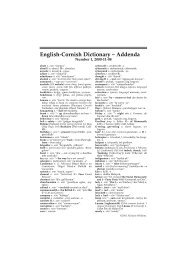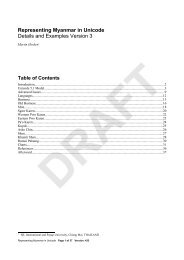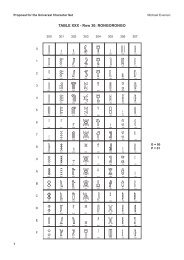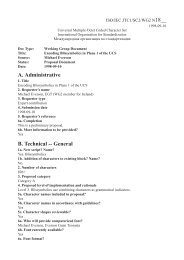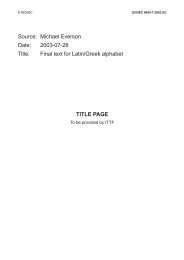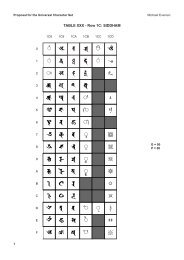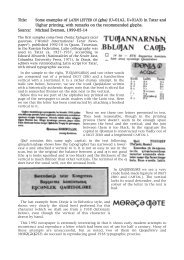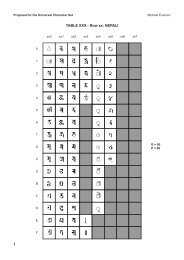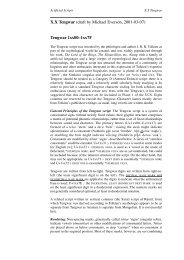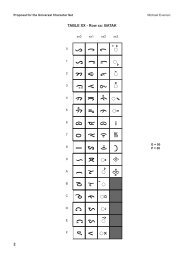ISO/IEC JTC1/SC2/WG2 N3194 L2/06-xxx - Evertype
ISO/IEC JTC1/SC2/WG2 N3194 L2/06-xxx - Evertype
ISO/IEC JTC1/SC2/WG2 N3194 L2/06-xxx - Evertype
You also want an ePaper? Increase the reach of your titles
YUMPU automatically turns print PDFs into web optimized ePapers that Google loves.
combining cyrillic titlo is also used to indicate abbreviations, but is not used with the letter titlos. See<br />
Figure 36.<br />
COMBINING CYRILLIC KAVYKA @º is used to indicate an alternative reading to only part of a word, as in<br />
Figure 29, where the feminine ending in the margin is substituted for the masculine ending in the text.<br />
In this case the COMBINING KAVYKA is placed directly over the relevant letters. Note that COMBINING<br />
KAVYKA is typographically as well as functionally distinct from U+03<strong>06</strong> COMBINING BREVE, which is<br />
visible in ми´лãÁй, the penultimate word of the example in Figure 29.<br />
CYRILLIC KAVYKA æ is used on either side of a word or passage of text to indicate a substitution or<br />
alternative reading, usually indicated in the margin likewise between two kavyki. Functionally this is<br />
similar to the use of U+2E02 LEFT SUBSTITUTION BRACKET and U+2E03 RIGHT SUBSTITUTION BRACKET,<br />
although the brackets are visually different. There is no difference between a KAVYKA used at the<br />
beginning of a word or phrase and a KAVYKA at the end. See Figures 28, 29.<br />
COMBINING CYRILLIC PAYEROK @Ω is frequent from the earliest period, originally to replace an omitted<br />
yer, later also to break up consonant clusters. See Figure 54.<br />
CYRILLIC PAYEROK ø is the spacing equivalent of the COMBINING CYRILLIC PAYEROK, used to replace an<br />
omitted yer, later also to break up consonant clusters. See Figure 19.<br />
SLAVONIC ASTERISK ∫ is a punctuation star used in ecclesiastical printing. It is a spacing character, but<br />
often kerns very closely over punctuation like COMMA, FULLSTOP, AND COLON. See Figure 35.<br />
VERTICAL TILDE ª is the spacing form of U+033E COMBINING VERTICAL TILDE, which represents the<br />
Cyrillic yerik, a character which functions similarly to the PAYEROK. We recommend the following notes<br />
be added to the Unicode Standard names list: For U+033E, add “used for combining Cyrillic yerik”; for<br />
VERTICAL TILDE, add “used for Cyrillic yerik”; both should have cross-references to the two payeroks.<br />
See Figures 19, 33.<br />
5. Additional letters for Abkhaz. Abkhaz has been studied scientifically since the mid-19th century. The<br />
first alphabet for Abkhaz was devised by P. K. Uslar in 1862, based on the Bzyb dialect. This<br />
orthography was used for textbooks and religious material until 1928, when a Latin alphabet was devised<br />
for Abkhaz by Soviet authorities. M. R. Zapadskij was the first to put Uslar’s handwritten alphabet into<br />
type, which was used until “the Translation Committee” further refined the alphabet; the examples from<br />
the translation of the four gospels in Figures 38a, 38c, and 38d are in this latter orthography. Most of the<br />
Cyrillic characters used in these early alphabets are already encoded. Figure 39 shows the Zapadskij and<br />
Translation Committee alphabets, and the unique characters missing from the UCS from each of those<br />
alphabets is proposed here.<br />
DWE ¿¡ is used in early Abkhaz orthography to represent [d w ]. See Figures 39a, 39d.<br />
DZWE ¬√ is used in early orthographies for Abkhaz to represent [dz w ]. See Figures 38c, 39b.<br />
ZHWE ƒ≈ is used in early orthographies for Abkhaz to represent [· w ]. The character is a fusion of a<br />
Cyrillic ZE to the base of the letter ZHE. It is not a divisible ligature. See Figures 38a, 38c, 39a.<br />
CCHE ∆« is used in early orthographies for Abkhaz to represent [t∫ :]. The character is a double<br />
Cyrillic CHE. It is not a divisible ligature. See Figure 39b.<br />
DZZE »… is used in Uslar’s orthography for Abkhaz to represent [dz]. The character is a fusion of a tiny<br />
Cyrillic ZE to the base of the letter DE. It is not a divisible ligature. See Figure 39b.<br />
5





